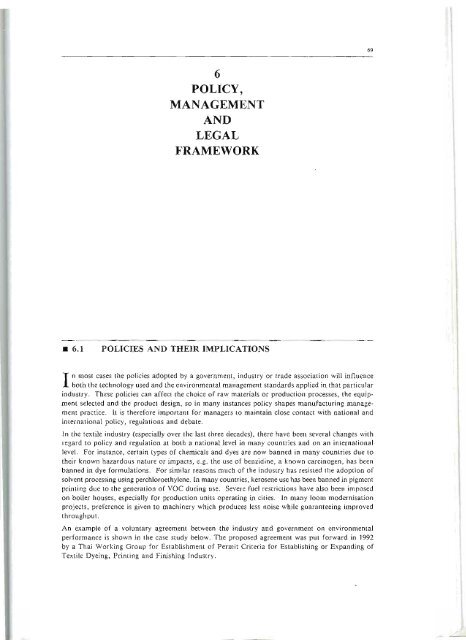Contributor, The Textile Industry and the Environment, UNEP
Contributor, The Textile Industry and the Environment, UNEP
Contributor, The Textile Industry and the Environment, UNEP
You also want an ePaper? Increase the reach of your titles
YUMPU automatically turns print PDFs into web optimized ePapers that Google loves.
6<br />
POLICY,<br />
MANAGEMENT<br />
AND<br />
LEGAL<br />
FRAMEWORK<br />
• 6.1 POLICIES AND THEIR IMPLICATIONS<br />
I<br />
nmost cases <strong>the</strong> policies adopted by a governmelll, industry or trade association will inl1uence<br />
both <strong>the</strong> technology used <strong>and</strong> <strong>the</strong> environmental management st<strong>and</strong>ards applied in that particular<br />
industry. <strong>The</strong>se policies can affect <strong>the</strong> choice of raw materials or production processes, <strong>the</strong> equipment<br />
selected <strong>and</strong> <strong>the</strong> product design, so in many instances policy shapes manufacturing management<br />
practice. It is <strong>the</strong>refore important for managers to maintain close contact with national <strong>and</strong><br />
international policy, regulations <strong>and</strong> debate.<br />
In <strong>the</strong> textile industry (especialJy over <strong>the</strong> last three decades), <strong>the</strong>re have been several changes \vith<br />
regard to policy <strong>and</strong> regulation at both a national level in many countries <strong>and</strong> on an international<br />
level. For instance, certain types of chemicals <strong>and</strong> dyes are now banned in many countries due to<br />
<strong>the</strong>ir known hazardous nature or impacts, e.g. <strong>the</strong> use of benzidine, a known carcinogen, has been<br />
banned in dye formulations. For similar reasons much of <strong>the</strong> industry has resisted <strong>the</strong> adoption of<br />
solvent processing using perchloroethylene. [n many countries, kerosene use nas been banned in pigment<br />
printing due to <strong>the</strong> generation of VOC during use. Severe fuel restrictions have also been imposed<br />
on boiler houses, especially for production units operating in cities. In many loom modernisation<br />
projects, preference is given to machinery which produces less noise while guaranteeing improved<br />
throughput.<br />
An example of a voluntary agreeUlent between <strong>the</strong> industry <strong>and</strong> government on environmental<br />
performance is shown in <strong>the</strong> case study below. <strong>The</strong> proposed agreement was put forward in 1992<br />
by a Thai Working Group for Establishment of Permit Criteria for Establishing or Exp<strong>and</strong>ing of<br />
<strong>Textile</strong> Dyeing, Printing <strong>and</strong> finishing <strong>Industry</strong>.<br />
69

















